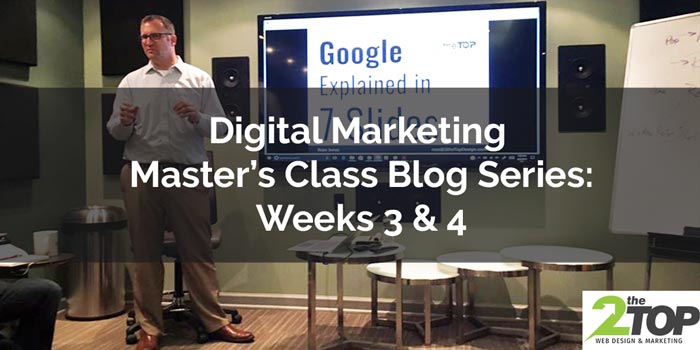Welcome to the weekly Digital Marketing Master’s Class Blog Series. My name is Riley Duncan, and I am a Digital Marketing Specialist for 2 the Top. I am very excited to be a part of the 2017 Summer Digital Marketing Master’s Class, where I will participate in all class activities as well as document the class through social media and this blog. The class runs for 14 weeks on Tuesday nights from 6 – 9 p.m. This is the second post in the series. See the first post here.

WEEK 3: On-Site Search Engine Optimization
After gaining a strong foundation for digital marketing in Week Two, Week Three of the Digital Marketing Master’s Class started our dive into SEO.
As part of our homework the previous week, we were tasked with writing a Yelp review. We started the class by taking a look at what we had posted.
Reviews on sites like Yelp can have a major impact on your business. Many people consult reviews before engaging with a company or buying a product, so having a presence on sites like Yelp can help you build your online reputation. While many of my classmates (including me) take a look at reviews fairly regularly, most of us had not actually written a review on Yelp before.
The exercise was a good one to get us familiar with the platform and start to understand what goes into a good review. A few of my classmates’ reviews were not displayed on Yelp because they had not yet built up credibility as a user. It makes sense that Yelp does this so that people cannot manipulate the system.
Once we finished looking at Yelp, we moved onto the content in the textbook.
Chapter 3 covers On-Site SEO, and more specifically:
- Choosing Target Keyword Phrases
- Relevance
- Quality
- Other SEO Considerations such as mobile optimization, site security and local search
Ross supplemented this content with his own insights, explaining the concepts and offering his knowledge on how he approaches some of these topics from a slightly different angle.
After taking a short break, we also got started on reviewing Chapter 4, which covers Off-Site SEO.
Links were definitely the primary off-site SEO factor that we focused on. As part of our homework, everyone was assigned to come up with a proposal to attract links to their website. In addition, we wrote a blog post and implemented the SEO
WEEK 4: Off-Site Search Engine Optimization and SEO Checklist
In Week Four, we spent some time away from the textbook to take a look at the SEO Checklist that we use at 2 The Top. The checklist covers a number of factors that fall under the umbrella of Architecture, Content, and Engagement.
A few of our classmates volunteered their websites, and Ross pulled them up in front of the class. He ran a few tools that included a page speed test, a look into the domain registration information, and a technical architecture check.
Going though this process with Ross proved very valuable, as everyone got an inside look into what an SEO audit looks like and which tools can be used to find different information.
Chapter 4 covers off-site search engine optimization, and specifically:
- Links
- Popularity Metrics
- Link Building
After our break, two classmates presented their proposals for attracting links to their website. Both students shared their ideas for about 5-10 minutes, and then the class had a chance to ask questions and give feedback. The proposals were both well thought-out, and it seems that both may go through with their proposals since they were working on websites that were either their own or their clients’.
As homework, we were assigned to read Chapter 5, which covers Paid Search Advertising (PPC) and watch two videos related to the topic.
I’m excited to get a chance to use the simulation tool for paid search. This gives everyone the opportunity to get some experience with PPC advertising without having to spend a lot of money.
Make sure to follow us on Facebook and Twitter for live updates, and I’ll post another blog in a couple weeks!
